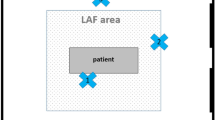Summary
The purpose of this paper is to study the effectiveness of a surgical horizontal filtered air flow unit on air and total hip replacement (THR) wound contamination.
Unidirectional air flow consists of air that has been driven through high efficacy 0.3 μ particle retaining filters (HEPA filters) and then directed through a grit in such a fashion that there is low turbulence and the air moves “en block”.
The conclusions of the study, which has been carried out in three groups of cases, are the following:
-
1.
The air near the wound, when the air flow is used, is significantly cleaner.
-
2.
The wounds at the end of the procedure, if the air flow is used, are significently less contaminated.
Similar content being viewed by others
References
Charnley, J.: Postoperative infection after hip replacement with special reference to air contamination in the operating room. Clin. Orthop. 87, 167–187 (1972)
Wilson, P. D., Jr., Amstutz, H. C., Czerniecki, A., Salvati, E. A., Mendes, D. G.: Total hip replacement with fixation by acrylic cement. A preliminary study of 100 consecutive McKee-Farrar prosthetic replacements. J. Bone Jt Surg. 54-A, 207–236 (1972)
Author information
Authors and Affiliations
Additional information
Assistant in the Orthopaedic Service of the University of Perugia (Director: Prof. G. Stringa). Hip Surgery Fellow at the Hospital for Special Surgery, New York.
Rights and permissions
About this article
Cite this article
Aglietti, P., Salvati, E.A. & Wilson, P.D. A study of the effectiveness of a surgical unidirectional filtered air flow unit during total prosthetic replacements of the hip. Arch orthop Unfall-Chir 77, 257–268 (1973). https://doi.org/10.1007/BF00418912
Received:
Issue Date:
DOI: https://doi.org/10.1007/BF00418912




